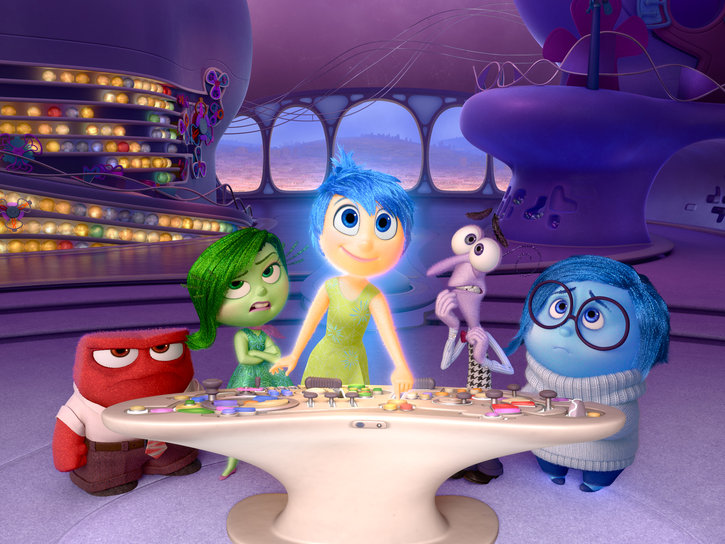It feels like it’s been a while since audiences have seen a Pixar movie – and not just because the beloved animation studio took the past year off.
Its last truly transcendent stroke of genius came all the way back in 2010 with "Toy Story 3," and even that was a sequel. Since then, the studio’s churned out the mostly forgettable "Brave" and a pair of lukewarm sequels ("Cars 2," "Monsters University"). It’s not that Pixar’s recent slate has been bad per say – OK, in the case of "Cars 2," that’s pretty much exactly the case – but that the studio certainly hasn’t been able to reach the crazy high standard audiences have come to take for granted, an admittedly hard task when expectations are basically set at all-time greatness.
However, toss in the backstage drama that went on with "Brave" and co-director Brenda Chapman, Disney’s off-branding of "Cars" into the preposterously white bread "Planes" movies and an upcoming line-up of films that appears to have more sequels to Pixar movies rather than real inspired Pixar movies, and you wouldn’t be blamed for thinking the studio’s iconic bouncy desk lamp sure looks a little dimmed.
Well, thanks to "Inside Out," the concerned crying about losing streaks and the end of a dynasty should be silenced for a bit – or at least drowned out by the crying of well-earned tears (and I’m not talking about a little, delicate, one-tear-down-the-cheek cry either; I’m talking about a big ol’ snotty ugly cry). As you would expect from a Pixar movie explicitly about, as the kids say, all the feels, "Inside Out" is an emotional powerhouse, full of laughs, beauty and incredible poignancy. Let the debate begin on whether it’s the best Pixar film – my vote: it’s up there – but it certainly might be the most Pixar film, an exemplar of the studio’s signature combination of bright, brilliant creativity and ageless, profound emotional deftness working in glowing harmony.
The main character is technically a young hockey-loving girl from Minnesota named Riley, but most of "Inside Out" follows the fuzzy felt-esque sentient emotions living in her head. There’s the perpetually upbeat Joy (Amy Poehler, perfectly re-channeling Leslie Knope), who was Riley’s first emotion, coming into existence right at her birth and viewing the world as a fascinating and beautiful blank slate. As Riley grows up and learns more, other emotions join Joy in Riley’s brain: Fear (Bill Hader), Anger (Lewis Black), Disgust (Mindy Kaling) and Sadness (Phyllis Smith of "The Office").
Together, the emotions work to guide Riley through each day (though usually with Joy the eternal optimist taking the lead) creating little color-coded memory marbles that are sent to the brain for long-term memory storage – or, in the case of special glowing ones, kept locked in their headquarters as a core memory, which help form and power Riley’s islands of personality.
It’s a fine system, until Riley’s family moves from Minnesota to San Francisco, causing the core memories to transform and take on other emotional qualities – especially around Sadness. In Joy’s haste to fix the problem and prevent her permanently mopey co-worker from effecting Riley, both of the emotions – as well as a bundle of core memories – are sucked out of headquarters into long-term memory and must make their way back while Fear, Anger and Disgust bumblingly take the reins of the increasingly unstable Riley.
Along the way, Joy and Sadness come across all sorts of cleverly imagined elements of the brain, from a duo of jelly bean shaped brain workers called "forgetters" walking down the coiling halls of Riley’s brain and vacuuming up dusty, faded memories into the dark, deep "memory dump" to the subconscious to Bing Bong (character actor Richard Kind), Riley’s old imaginary friend – a buoyantly happy mix of elephant, raccoon and cotton candy with a song-powered wagon space rocket. And those are just a few of the cleverly conceived wrinkles that form and populate the densely wound, forward charging brain of "Inside Out."
If that all sounds a little chaotic, well, occasionally it is. The screenplay – crafted by Pete Docter, Josh Cooley and Meg LeFauve from a story by Docter and Ronnie del Carmen – not only has to balance Joy and Sadness’s adventures inside Riley’s brain and the inventive world-building throughout it, but also the delicate emotions going on in the real world, in Riley’s seemingly crumbling new environment. Most of the time, however, the movie finds the right balance, playing more exhilaratingly inventive rather than exhausting – on both a conceptual and visual level. The figments of Riley’s brain are smartly realized on the page but even more ingeniously and gorgeously brought to life through Pixar’s predictably rich and colorful animation (even "Cars 2" built an incredibly full and detail-rich world for its dumb Larry the Cable Guy escapades), including playful diversions into places like dreams and abstract thought.
From a creative and visual standpoint, "Inside Out" is simply a fun and fascinating movie to behold, a film that had clearly started with a unique idea, ran with it and never stopped running. And while the movie’s constantly throwing new unique takes on the growing mind, it still has the time in the early going for lovely emotional grace notes like Joy peacefully skating along with one of Riley’s earliest on-ice memories or just simply gazing with wonder upon her host’s white mental canvas beginning to take in the world.
Those emotional notes become all the more pronounced and poignant as "Inside Out" dives into Riley’s real world struggles. Without Sadness – and with Joy refusing to let Sadness interfere, assuming she’ll just make matters worse – she’s unable to cope with her feelings to the point of depression – of feeling nothing at all. Her islands of personality begin to shut down and break away. Happy memories turn cold and melancholy. The headquarters’ panel turns faulty and grey. It’s a surprisingly nuanced and moving tribute to allowing oneself a complete emotional life, to the value of all feelings and the catharsis of sadness – no matter how painful it can sometimes be for a while.
Even more so, "Inside Out" becomes a powerful and honest tribute to growing up, of how so many of the things we experience – memories, moments, interests, relationships, figments of imagination and on – that once meant so much eventually fade into the brain’s distance but still help form and create the people we become. It’s a beautiful message beautifully told. Admittedly, younger children in the audience will likely only get the basics of these deft themes, but for pretty much anyone over 10 who’s gone through a transition growing up, these emotionally touching, quiet but universally felt realities are destined to crank on the waterworks. You will believe a pink creature named Bing Bong can make the brawniest of Brawny men cry.
Also an important part of growing up with a full emotional life? Laughter. And for a movie that spends a good amount of time focusing on childhood depression and tears and sadness, it shouldn’t be forgotten that "Inside Out" is still a very funny film. Perhaps not the funniest; some of the punchlines land a little childish or predictable by Pixar standards – perhaps as an apologetic balance to the heavier adult-oriented themes and dense psychological gallivanting at play (then again there’s an extended, not to mention brilliant, comedic set piece dedicated to deconstructive abstract thought theory, so maybe it’s not all kid-approved softballs). Even so, most of the jokes still score strong laughs – from a running earworm gag to a cloud murder to the pivotal plot importance of a dream boyfriend – thanks to a fun script, the uniquely expressive vocal cast and its playful visual wit.
After a few years of fine turnouts, "Inside Out" is the return to remarkability audiences knew Pixar had in them. Like the studio’s finest works, it plays like such a complete emotional work. It’s such a cliché, but in the movie’s case, it’s true: You’ll laugh, you’ll cry, you’ll gape and you’ll be disgusted (during "Lava," the unfortunately cloying and over-narrated opening short). It only seems right a movie about the beauty of all emotions would hit all of them so rewardingly.
And as for viewing recommendations, I recommend seeing it in 3-D – not because the extra effect is particularly noteworthy, but because the tinted lens quite nicely hide the sobbing monsoon season likely raging underneath. Then again, you don’t have to be ashamed; "Inside Out" earns those tears.
As much as it is a gigantic cliché to say that one has always had a passion for film, Matt Mueller has always had a passion for film. Whether it was bringing in the latest movie reviews for his first grade show-and-tell or writing film reviews for the St. Norbert College Times as a high school student, Matt is way too obsessed with movies for his own good.
When he's not writing about the latest blockbuster or talking much too glowingly about "Piranha 3D," Matt can probably be found watching literally any sport (minus cricket) or working at - get this - a local movie theater. Or watching a movie. Yeah, he's probably watching a movie.







